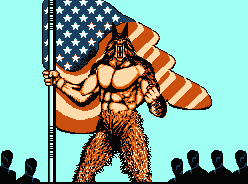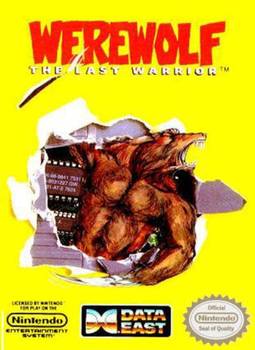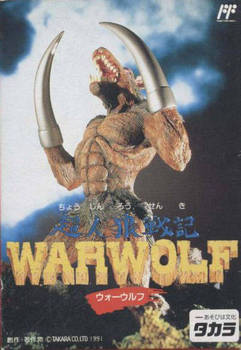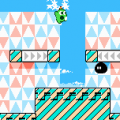After putting one on one fighting games on the map with Karate Champ in 1984, Data East would continue to hit it big in the arcades throughout the late 80s with the release of Karnov, Bad Dudes vs. Dragon Ninja and several other popular games. With home systems like the Famicom continuing to grow in popularity in Japan at the same time, however, they also began producing games exclusively for it and other home systems. Werewolf: The Last Warrior is among the first of these to be released in the US. Several of these ports and NES exclusives were made by SAS Sakata, a name which has been around since 1985 but focused almost exclusively on collaborating with Data East. Werewolf: The Last Warrior would also be the one of the few original game Data East would create in conjunction with them to be released outside of Japan.

While the game does have some simple intermissions between stages, very little of the game’s plot is detailed in the game itself. Fortunately, however, in an attempt to capitlize on the popular comeback super hero comics were making in throughout the late 80s, Data East was kind enough to include one with every copy of the game. It details the trials of a Native American warrior called Chief War Wolf undergoing a painful ritual by which he masters the art of turning into a wolfman. He gains this ability by communing with a spirit depicted as a glowing white orb that is oddly similar to the one seen rising out of the Chrysler building at the end of Mad Motor, another Data East game about a werewolf warrior.
As Chief War Wolf is mastering his newfound power, an exiled, bitter, and extremely dorky Dr. Faryan perfects a horrifying new chemical weapon. Through his henchman, he manages to fill an entire space shuttle with the stuff before it launches. Once the shuttle deposits its payload, millions on Earth are killed, after which millions more are become mutated horrors, several of which bear an uncanny resemblance to creatures drawn by John Byrne. Conveniently, Chief War Wolf misses out on all of this and emerges from his ritual to a broken, monstrous world. Fortunately, new players can read this schlockly but fun introduction to the characters via scans on Ben Lathrop’s Tomb of the Undead.
Werewolf: The Last Warrior Issue #1 (1990)
Impressively, this comic was packaged with the game a solid year before X-Force would first appear, and two years before Image Comics would come out with Wild C.A.T.S.. The comic and game even predates 1991’s X-Men Volume 2. 1990 also places Werewolf: The Last Warrior just two years after Marvel Comics’ Wolverine character would receive his own monthly series. In short, Werewolf: The Last Warrior‘s character designer – most likely Eiichir? Nakatsu going by the game’s credits – had their finger on the pulse, beating tons of Wolverine imitators and comics built around the now cliche “extreme 90s attitude” to the punch (not unlike the other Data East werewolf game, Mad Motor successfully taking inspiration from a few 70s/80s punk movies and Go Nagai). It also wouldn’t be til a year later that audiences would see the most famous fictional character that makes use of his hands transforming into blades, the T-1000 in Terminator 2: Judgment Day. Long story short, the two most popular things a person could create in pop culture in the early 90s was a person with blades for hands or a feral man. Werewolf: The Last Warrior beats them all to the punch at once! An entire legion of metal blade armed and/or wolfen personalities, predated by Data East in 1990! That “extreme attitude” is present even on the game’s cover. Data East really knew what they were doing here. We see War Wolf ripping his way out of an NES cartridge and right out of the game’s box! The box is even bright yellow in case early 90s kids somehow forgot Wolverine existed.
Pictured Left: The Legend, Right: Mere Dabblers in the Blade Arm / Werewolf Aesthetic
Werewolf: The Last Warrior‘s enemies, however, while fun to fight are also fairly unoriginal. Marvel Comics fans will notice a few designs inspired by X-Men foes like the Brood, Magneto, and Juggernaut along with some more obscure selections. At a glance it looks like the original and bizarre assortment of enemies Data East had become known for with Karnov and Atomic Runner Chelnov. There are a few standouts like bulky breakdancing enemies with with an M on the back of their red vests (could they be related to the protagonist of Mad Motor?!). The most amusing is an armed guard enemy that exclaims “OH!” whenever he sees you. When this enemy is facing to the right the sprite is reflected, making him shout “!HO” at the player instead. Fortunately, they drop their weapon upon being defeated, allowing for the brief but ultimate situation of being a werewolf with blades for hands AND a rifle. Though War Wolf can only fire one shot before running out of ammo, requiring him to find more hidden in the environment or go back to slashing enemies with his massive blade arms.
The most challenging confrontations in the game, however, will be with the environment rather than its hostile population. Each level is littered with uneven terrain, precarious jumps, and tons of precipes to carefully climb up and over. Even the game’s first level can be particular brutal for new players to complete because of its combination of spiked floors and ceilings lined with lasers. Fortunately, if one knows how to control the Werewolf these obstacles are much less formidable than they seem. Chief War Wolf can punch enemies and also walk around while crouching to avoid high attacks and projectiles. Most impressively however, is his ability scream “NOO!” so loudly that a “NOO!” shaped projectile flies from his mouth, doing as much damage to anything it hits as his werewolf form’s blades! Once he actually transforms into the werewolf, however, things get much more interesting. As a werewolf, War Wolf (why did they do this?) has an impressive attack range and his attacks do twice the damage as War Wolf’s weak human punches.
More important, however, is his increased agility. As a werewolf he gains the ability to climb and jump off of walls like Ryu Hayabusa in the Ninja Gaiden series, and can even climb across ceilings. On top of that, he can also perform a double back flip by pressing the A and B buttons simultaneously. This may seem of limited use at first as it requires some precision to successfully land on some of the game’s smaller platforms with it. The real purpose of this technique, however, is that War Wolf is completely invincible while flipping around. Mastering this makes the game extremely rewarding as it can simultaneously get him out of harm’s way while also putting him in a better position to attack or evade his enemies. It’s also a great addition as many of the game’s levels and bosses were designed with this ability in mind. A good example is the second half of level two, a gutted skyscraper with almost no ground to stand on, forcing the player to spend almost the entire time wall climbing from place to place while avoiding lightning bolts that will instantly kill War Wolf.
Werewolf: The Last Warrior also features a massive quantity of hidden items that can be found by attacking any of the objects littering the game’s levels. There’s a nice gamble to this, as many of these will require use of War Wolf’s agility to reach, and there’s also an item that will reduce him back to a mere human while also significantly decreasing his energy. However, thanks to War Wolf’s powerful scream, some boss encounters are actually much easier in human form. There’s also a much more immediate risk of exploring the few branches levels offer: Each level is on a timer, and exploring too much will mean a trip back to the beginning of the level if time runs out.
The game strikes this great balance between having to carefully prioritize every move while still pushing forward. The only respite is at the beginning of each level, where the ghost of War Wolf’s former mentor from the comic, Kinjin, appears to offer some advice. The artwork for these and other intermissions are effective, and at times easily evocative of some of the darker visuals seen in Ninja Gaiden II: The Dark Sword of Chaos. Unfortunately Kinjin’s advice is generally less helpful than the atmosphere evoked by his apearances. Still it’s a nice touch, and one of many cool details in the game. Another one is found halfway through the second level post apocalyptic urban area. Towards the halfway point, the level’s boss makes a brief appearance before running away. As War Wolf approaches him survivors appear in the levels’ background cheering for him to fight.
It also features some very catchy music. While Azusa Hara was not involved in the game’s sound design, her absence is not felt as strongly as it is in other Data East games of the time thanks to the presence of Y?suke Takahama and Sh?go Sakai. Without being constrained by porting someone else’s music, he and the game’s two other sound designers have created an urgent and generally optimistic tone for the game. While the game is of course quite a bit different from Data East’s Jake Hunter series, fans will likely appreciate Sakai and Takahama’s sound here as well. Werewolf‘s soundtrack even includes a remixed song from Tantei Jinguuji Saburou – Toki no Sugiyuku Mama ni, a Jake Hunter installment released just a few month prior.
While it was created with US audiences in mind, Werewolf: The Last Warrior was localized for Japan by Takara one year after its US release. Not just a rush job, SAS Sakata rearranged most of the first level to make it a more gentle introduction to the game’s action. They also even got Susumu Sugita to take a break from making Venom and Vampirella sculptures for Kaiyodo to create the awesome model seen on the Japanese game’s cover and advertising. The controls are also reversed, with Japanese players using the B button to attack and the A button to jump instead of the opposite in the US. Why SAS Sakata chose to go against the grain in the first place is a mystery, as using A to attack in NES action games was typically the domain of European NES conversions like Sky Shark and Alien 3. All of the characters names have been changed as well, though not much is really added by the alteration. Kinjin’s named is changed to Genju, and Chief War Wolf is now named Ken. In Chou Jinrou Senki: Warwolf, his name is Ken and he transforms into Warwolf, while in the US his name is War Wolf and he transforms into Werewolf. The villain, Dr. Faryan is also now known as Dr. Gordon (perhaps someone was at Takara was a Godfrey Ho fan).
Despite the well thought out encounters and level design, either version of the game is far from easy. The difficulty is also pretty consistent from start to finish as players will need to be able to flip, jump, claw, and climb efficiently even to beat the first level. The game has a well earned reputation today for being extremely challenging, but at the same time it’s impressive for a one off NES game like Werewolf to be difficult in a way not related to glitches or badly balanced combat. The result is a game that, while it may have been conceived as a quick cash in on comic loving US audiences, ended up being a polished and intense addition to the NES’ library.
Chou Jinrou Senki: Warwolf Alterations
American
Japanese
American
Japanese
American
Japanese
American
Japanese
American
Japanese
American
Japanese




